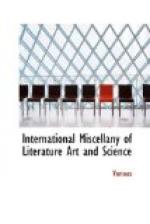“Cast aside every extrinsic recommendation, and depended entirely on form and effect. He took the greatest care that his shadows should tell boldly and in masses. He was cautious in introducing them, and always reduced them as much as might be compatible with the complete development of the figure. He never introduced a fold that could be dispensed with, rarely deviated from long lines, and avoided abrupt foldings. His dislike to ornament in sculpture was extreme.”
In architecture he liked it no better. Superfluous embellishment in this branch of art he held to be either concealment of inability or a development of puerile taste. Fine buildings, he asserted, must still be fine, if divested of every ornament and left altogether bare. Apparent artlessness is the consummation of art. The busts of Chantrey bear immortal testimony to the fact.
The manly and courageous view which Chantrey took of his duties as an artist sustained him in every attempt he made to impress that view upon his works. He is described as “shrinking from no difficulty,” as being “deterred by no embarrassment that labor, assiduity, and good sense could surmount.” His independence was as great as his energy, and both smacked of the Saxon blood in his veins. The manner of the sculptor was rough and unceremonious, but he exhibited as little coarseness in his demeanor as in the massive figures of his chisel, which might offend some by their heaviness, but which gratified all by their undoubted grandeur and dignity. The quiet yet splendid generosity of Chantrey was equally characteristic of his country. He assisted the needy largely and unobtrusively. Instances of his bounty are on record which would do honor to the wealthiest patron of art. How much more luster do they shed upon the indefatigable day-laborer? If we follow the sculptor from his studio to the open fields, he is still national to the backbone. He escapes from London to pass days with his rod at the river side, or to walk with his gun on his arm “from 10 o’clock until half-past 4 without feeling the least fatigue.” Yesterday he killed two salmon in the Conway, at Llanrwst, and to-day he kills “28 hares, 8 pheasants, 4 partridges—total, 40 head, all from my own gun.” Visit him at home and e is the prince of hospitality. His dinners are of the best, and he is never happier than when presiding at them. Like an Englishman, he was proud of the illustrious society his success enabled him to summon around him, and, like an Englishman too, he had greater pride still in dwelling upon the humbleness of his origin, and in recounting the history of his difficult journey from struggling obscurity to worldwide renown.




